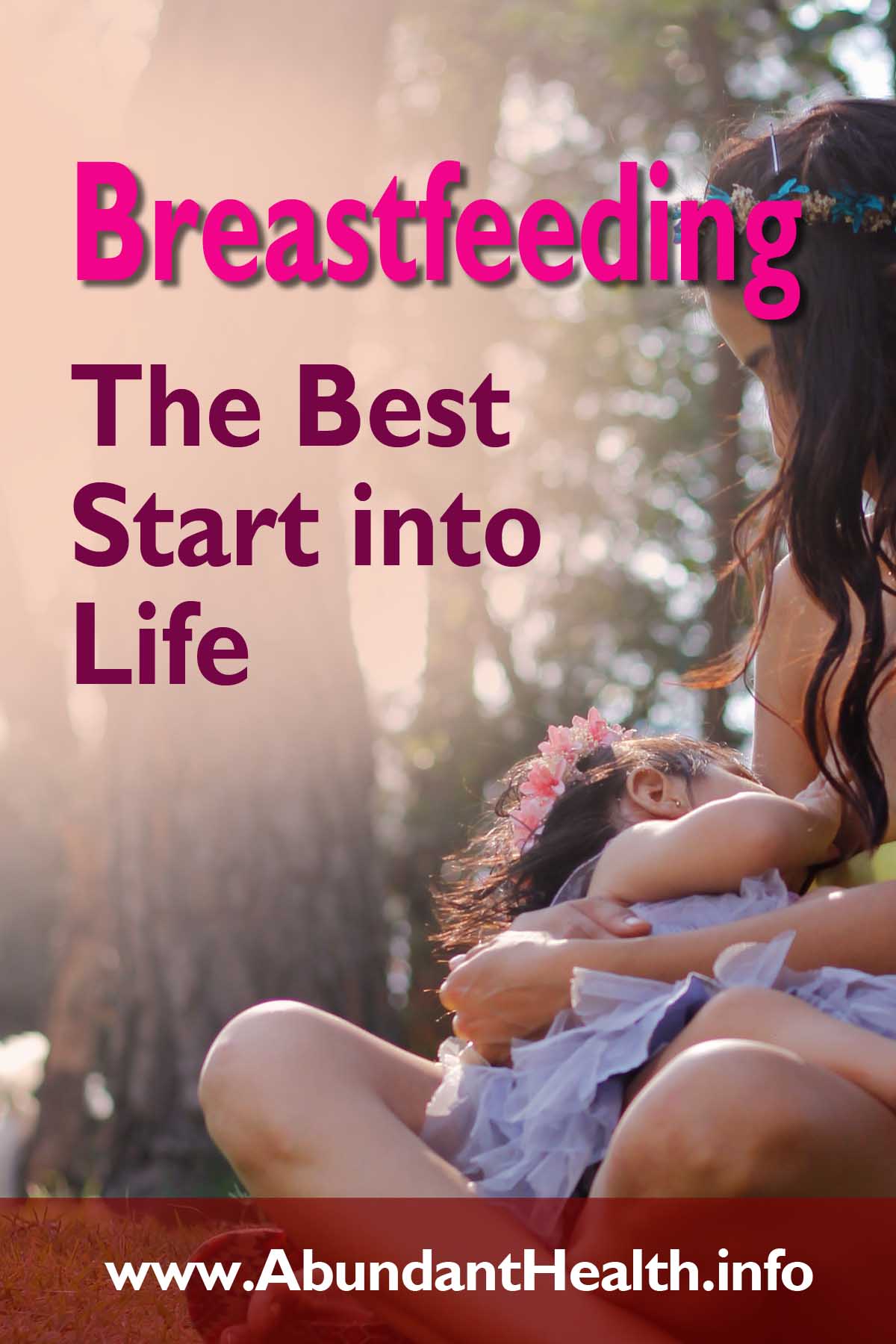Breast milk makes smart! On average, breastfed children have an intelligence quotient that is three points higher. Breast-fed children are less likely to suffer from allergies. The close contact with the mother gives the baby a feeling of security. The nutritional composition of breast milk is optimally tailored to the newborn. Breast milk is always sterile and at the right temperature. These are all advantages that far make up for the little effort involved in starting breastfeeding.

91% of all expectant mothers want to breastfeed. But only about 45% breastfeed for four months, and only 13% for the entire recommended six-month period. Breast milk is the best food in the first year of life. Its composition is precisely adapted to the infant’s need for water, energy and nutrients. In addition, it is always sterile and always at the right temperature.
The intensive skin and body contact stimulates the senses. The baby sees, feels, smells, hears and tastes the mother. Sucking strengthens the jaw muscles, which is beneficial for the later chewing capabilities and language development.
Breast Milk and Cow’s Milk Compared
Compared to cow’s milk, mature breast milk has much less calcium and less casein. That makes sense. A small calf doubles its birth weight much faster than a human being. That is why the calf needs more calcium for bone formation. But breast milk has more available carbohydrates in the form of lactose, which is the infant’s most important energy source. Various carbohydrate fractions also act as growth factors to promote the proliferation of bifidobacteria, which protect the intestines of the newborn from pathogenic germs and parasites.
The proportion of the unsaturated fatty acids in breast milk is higher than in cow’s milk. They are important for the development of the nervous system and the brain. They can also be found accumulated in the retina of the eye. The amino acid taurine, which babies cannot produce themselves in sufficient quantities, can be found in breast milk. Taurine has a particularly positive effect on the infant’s organ development and is important for fat digestion.
The mineral content is significantly lower in breast milk than in cow’s milk. The infant has not yet the capacity to excrete the excess minerals through the kidneys. That is why cow’s milk may only be used diluted in infant nutrition. Breast milk contains more vitamins A and E than cow’s milk. Trace elements such as iron, zinc, copper, manganese, but also calcium are bound to specific fractions in breast milk and can be absorbed much more easily than from cow’s milk.
Changes in Breast Milk
Some of the energy and nutrients were already stored during pregnancy and are now accessible for breastfeeding. The hormone prolactin made the breast grow and prepared it for milk production. The newborn should be breastfed immediately after birth, because the sucking stimulus is the trigger for a particularly strong release of prolactin. Thus the milk production really gets going. The colostrum is produced in the first one to three days after the birth. It has a strong yellow color and is very important for the child, as it has a high content of antibodies and thus offers comprehensive protection against infection. We can call it the first vaccination for the newborn.

From around the third day, the transitional milk is formed. It becomes more fluid and whiter. Until mature breast milk is formed, the proportions of fat and carbohydrates increase and the protein content decreases. At the same time, the amount of milk increases. Even during the breastfeeding, the composition is changing. The foremilk, at the beginning of a feeding, is more watery and translucent. The baby should first take in enough fluids. The hindmilk then becomes richer in fat and satisfies hunger. It is therefore important that the mother takes enough time to breastfeed so that the child gets enough of the high-fat milk.
It should always be fed from both breasts. This is how milk production really gets going as a result of the sucking stimulus. In the past, only one breast was applied per meal, with the result that mothers soon stopped breastfeeding for fear that the child was getting too little milk. If the child stubbornly refuses a breast for any reason, one breast can be used exclusively without any problems. The author of this article has successfully experienced this for 15 months with her own child. If the mother is eating wholesome food, the baby does not need anything except breast milk for the first six months of life. Only then you should start slowly introducing complementary foods.
Allergy Protection
Breast milk is the best protection against allergic diseases. In the first few months of life, the intestinal mucous membrane of the infant is much more permeable to protein from the diet than in the adult. When the baby is breastfed, only species-specific protein is absorbed, so no immune reaction is triggered. In bottle-fed infants, alien protein can enter the blood without being broken down, and can lead to an immune reaction in the case of allergic predisposition. Cow’s milk allergies are the most common allergies in infancy. If someone in the family is known to have a cow’s milk allergy, the child should be fully breastfed for at least 6 months.

Industrial Infant Formula
If, for whatever reason, breastfeeding is not possible, industrially produced baby formulas must be used. It is usually offered in powder form. Most formulas are based on proteins from cow’s milk, which have a higer allergic potential. There are soy-based formulas available, who can be allergenic as well. In protein hydrolysate formulas, the proteins are broken down into smaller components, which can reduce their allergy potential. There are some follow-on formulas, which are less adapted to breast milk. They are richer in protein and have a higher mineral content. That is why they should only be fed from the age of 6 – 12 months, depending on their composition.
Problematic Substances in Breast Milk
The possible high concentration of toxic chlorinated hydrocarbons in breast milk can be a disadvantage. Such substances are found in pesticides, but also in plastic products. The mother could have also absorbed them with grilled and cured foods. However, it can be said that the content of such substances in breast milk has been falling steadily since the 1980s, as the danger of such compounds was recognized and some of them were banned. Toxins are stored in the mother’s depot fat. That is why a nursing mother should never flirt with radical weight loss. In any case, the weight usually decreases slowly during breastfeeding.
Other food ingredients can also pass into breast milk. That is why alcohol, black and green tea, soft drinks, energy drinks and coffee should be avoided. Nicotine also passes into milk. You have to experiment with bloating vegetables or fruits that can cause red butts in the nursing babies. It differs from mother to mother and from child to child. Despite such possible contaminations of breast milk, the advantages of breastfeeding predominate, at least in the first six months of life.

Persevere
Perseverance is the most important advice. Breastfeeding only becomes nice and relaxing after a few days. Breastfeeding stimulates the shrinking of the uterus. This can be very painful in the first few days. The newborn also reports very often at the beginning until a comfortable rhythm is found. Feeding at night is also a nuisance at first. But you soon find a way to make it more comfortable, and some children also manage to sleep through the night, the dream of all mothers. It is very important to get information about breastfeeding before giving birth. The choice of hospital for birth can also determine whether or not breastfeeding is successful. Does the mother get support there and the necessary help with the initial difficulties? Every mother should be encouraged to breastfeed for at least 6 months, because breastfeeding is simply the best start in life.

Esther Neumann studied Nutrition at the University of Vienna. Since then she served as an author for the health magazine “Leben und Gesundheit” and conducted health lectures in various locations of Austria.
Leave a Reply